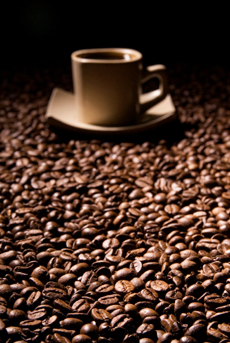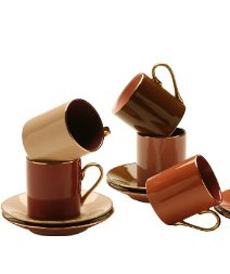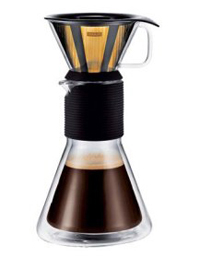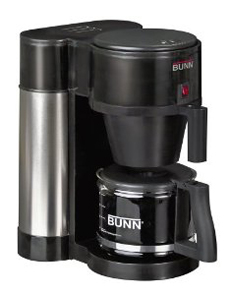Coffee Glossary: A Glossary Of The Different Coffee TypesPage 3: Terms Beginning With D To E This is Page 3 of an 6-page article. Click on the red links below to visit other pages. This glossary is protected by copyright and cannot be reproduced in whole or part. You are welcome to link to it.
|
 Don’t buy more coffee than you can use in a week. Fresh-roasted beans deliver the best flavor. Have a fresh cup! Photo by Joan Vicent | IST. |
|
| Decaffeinated: Coffee with 97% or more of the caffeine removed. Decaffeinated is not the same as caffeine-free. A 2006 study conducted at the University of Florida that purchased coffee at a variety of different coffee shops and restaurants showed that five to 10 cups of decaffeinated coffee contain as much caffeine as a cup or two of caffeinated coffee. Decaffeinated espresso shots varied widely, from 3 to nearly 16 milligrams, while the caffeine content of the decaffeinated brewed coffee ranged from 12 to 13.4 milligrams per 16-ounce serving. By comparison, a can of Coca-Cola has about 31 milligrams. SOURCE: McCuster, R. Journal of Analytical Toxicology, October 2006; vol 30: pp 611-613. |
||
| Decaffeination Process: For a coffee to be called decaffeinated, it must be 98% caffeine-free. Coffees are decaffeinated in their green state using one of three processing methods: the Traditional or European Process, which uses methyl chloride; the Swiss, SWP, or Water-Only Process (which is certified organic); or the Sparkling Water Process, using water and carbon dioxide. Fine coffees are not decaffeinated with chemicals. The water-only process uses water and carbon filters, like a water-purifying system, prior to roasting. With the sparkling water process, a pressurized liquid form of carbon dioxide is circulated past the beans to remove the caffeine; the caffeine adheres to the carbon dioxide which is removed, taking the caffeine with it. See also methyl chloride.
|
||
| Delicate: Characterized by a fragile, mellow or subtle flavor. Found in washed Arabica coffees. Demitasse: French for “half cup,” a half-size cup for espresso or other strong coffee. While some people use the words “espresso cup” and “demitasse cup” interchangeably, a demitasse has traditionally been a cup with thinner walls and porcelain instead of ceramic. |
||
| Dirty: A muddy or otherwise “dirty” taste underlying the coffee showing flavor taints, defects and other faults. Some coffees, e.g. Indonesian, has innate “forest floor” flavors.
|
 Demitasse cups from Yedi are available at Amazon.com. |
|
| Doppio: A double shot of espresso. Doppio means “double” in Italian. |
||
| Drip Coffee: Made by dripping boiling water over coarsely ground coffee. The water filters through the coffee and falls into the pot. The brewing process is slower than regular coffee or espresso, and the hot water is in contact with the ground coffee for much longer. A cup of drip coffee actually has more caffeine than one shot of espresso.
Both of these coffeemakers are drip units. The coffeemaker at the left is a manual drip style from Bodum; the one at the right is an electric drip machine from Bunn. Dry: A coffee with a parching or drying aftertaste, generally due to over-drying the coffee during production. Dull: Coffee that has lost its original (or usual) zest and pungency: it may be too old, of inferior quality or poorly prepared.
|
  |
|
| Earthy: A flavor and aroma characteristic of some coffees that resembles freshly-turned soil, dirt or clay. It is found in low-grade coffee and is usually due to poor preparation conditions; although it is found in some higher-quality coffees from Sumatra as well, whose mushroom and herbal characteristics are enjoyed by some coffee-drinkers. In many origins, the coffee is literally dried on the ground, and the oils in the coffee absorb flavors from the earth on which it sits.
Espresso: A rich, black coffee made by forcing water through packed, finely ground roast coffee at high pressure, and at a high rate of speed. The standard serving is a single 1-ounce shot made with 7g of finely ground coffee extracted for between 25 and 30 seconds. An espresso roast is the darkest of roast beans yielding the strongest of brews. A properly prepared espresso will fill half the espresso cup, with the crema forming perfectly on top. Espresso is meant to be drunk immediately. See our Espresso Glossary for more espresso definitions.
|
 Photo courtesy SXC. |
|
| Espresso Corretto: Espresso with a shot of grappa (coretto is Italian for “correct”). |
||
| Espresso Doppio: A double shot of espresso poured over one shot of fresh hot water. |
||
| Espresso Con Panna: An espresso with whipped cream on top (panna is Italian for whipped cream). |
||
| Espresso Granita: Espresso mixed with brown sugar and frozen into an ice. |
||
| Espresso Lungo: A single shot of espresso brewed from a much stronger extract (two full ounces of espresso are extracted from a single shot). Lungo is Italian for “long” or “lengthy.”
Espresso: A rich, black coffee made by forcing water through packed, finely ground roast coffee at high pressure, and at a high rate of speed. The standard serving is a single 1-ounce shot made with 7g of finely ground coffee extracted for between 25 and 30 seconds. An espresso roast is the darkest of roast beans yielding the strongest of brews. A properly prepared espresso will fill half the espresso cup, with the crema forming perfectly on top. Espresso is meant to be drunk immediately. See our Espresso Glossary for more espresso definitions.
|
 The book, I Love Coffee! by Susan Zimmer, features an espresso macchiato on the cover (topped with some nifty foam art). Get the book. |
|
| Espresso Macchiato: Espresso with a dollop of warm, frothed milk added, much less than a latte. The proportions are one part of espresso to one part foam. Macchiato means “marked” or “spotted.” |
||
| Espresso Ristretto: A single shot of espresso that is brewed stronger than regular espresso but not as strong as a lungo (one ounce of espresso is extracted from a single shot). |
||
| Espresso Romano: An espresso with a squeeze of lemon juice. |
||
| Estate Grown: Coffee grown on large farms as opposed to small peasant plots, usually old family-owned plantations. Exotic: Unusual aromas and flavors such as berry, floral or spicy. Extra: The second best grade of coffee. The best grade is called supremo. Continue To Page 4, Terms F & I |
||
© Copyright 2005-2026 Lifestyle Direct, Inc. All rights reserved. All images are copyrighted to their respective owners.